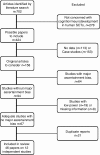Neurocognitive outcomes of individuals with a sex chromosome trisomy: XXX, XYY, or XXY: a systematic review
- PMID: 20059514
- PMCID: PMC2820350
- DOI: 10.1111/j.1469-8749.2009.03545.x
Neurocognitive outcomes of individuals with a sex chromosome trisomy: XXX, XYY, or XXY: a systematic review
Abstract
Aim: To review systematically the neurodevelopmental characteristics of individuals with sex chromosome trisomies (SCTs).
Method: A bibliographic search identified English-language articles on SCTs. The focus was on studies unbiased by clinical referral, with power of at least 0.69 to detect an effect size of 1.0.
Results: We identified 35 articles on five neonatally identified samples that had adequate power for our review. An additional 11 studies were included where cases had been identified for reasons other than neurodevelopmental concerns. Individuals with an additional X chromosome had mean IQs that were within broadly normal limits but lower than the respective comparison groups, with verbal IQ most affected. Cognitive outcomes were poorest for females with XXX. Males with XYY had normal-range IQs, but all three SCT groups (XXX, XXY, and XYY) had marked difficulties in speech and language, motor skills, and educational achievement. Nevertheless, most adults with SCTs lived independently. Less evidence was available for brain structure and for attention, social, and psychiatric outcomes. Within each group there was much variation.
Interpretation: Individuals with SCTs are at risk of cognitive and behavioural difficulties. However, the evidence base is slender, and further research is needed to ascertain the nature, severity, and causes of these difficulties in unselected samples.
Figures
References
-
- Jacobs PA, Melville M, Ratcliffe S, Keay AJ, Syme J. A cytogenetic survey of 11,680 newborn infants. Ann Hum Genet. 1974;37:359–76. - PubMed
-
- Hamerton JL, Canning N, Ray M, Smith S. A cytogenetic survey of 14,069 newborn infants. I. Incidence of chromosome abnormalities. Clin Genet. 1975;8:223–43. - PubMed
-
- Nielsen J, Sillesen I. Incidence of chromosome aberrations among 11 148 newborn children. Humangenetik. 1975;30:1–12. - PubMed
-
- Morris JK, Alberman E, Scott C, Jacobs P. Is the prevalence of Klinefelter syndrome increasing? Eur J Hum Genet. 2007;16:163–70. - PubMed
-
- Geerts M, Steyaert J, Fryns JP. The XYY syndrome: a follow-up study on 38 boys. Genet Couns. 2003;14:267–79. - PubMed
Publication types
MeSH terms
Grants and funding
LinkOut - more resources
Full Text Sources



